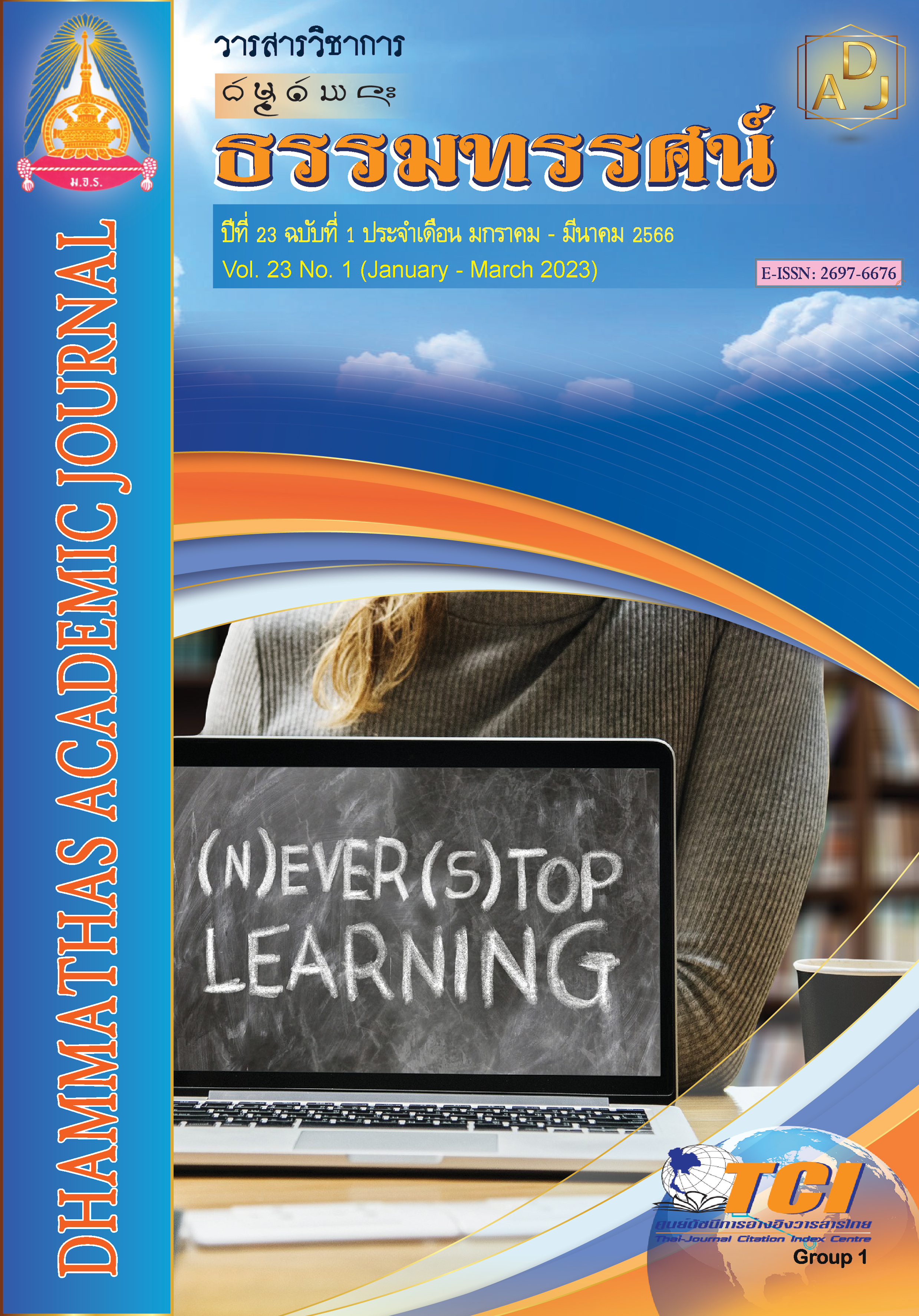นวัตกรรมการสื่อสารเพื่อสร้างภูมิคุ้มกันปัญหายาเสพติดและการท้องไม่พร้อมของเยาวชนกลุ่มเปราะบางในจังหวัดขอนแก่น
Main Article Content
บทคัดย่อ
การวิจัยครั้งนี้ มีวัตถุประสงค์เพื่อ 1) ศึกษานวัตกรรมการสื่อสารเพื่อสร้างภูมิคุ้มกันปัญหายาเสพติดและการท้องไม่พร้อมของเยาวชนกลุ่มเปราะบางในจังหวัดขอนแก่น 2) วิเคราะห์นวัตกรรมการสื่อสาร 3) พัฒนานวัตกรรมการสื่อสาร และ 4) จัดทำคู่มือนวัตกรรมการสื่อสาร เป็นการวิจัยแบบผสมผสาน (Mix Methods Research) กลุ่มตัวอย่างที่ใช้ในการวิจัยได้จากการคำนวณตามสมการการสุ่มตัวอย่างกรณีไม่ทราบจำนวนประชากร ได้ขนาดกลุ่มตัวอย่างจำนวน 100 คน และได้ทำการสุ่มตัวอย่างด้วยวิธีการสุ่มอย่างมีระบบ (Systematic Random Sampling) เครื่องมือที่ใช้เก็บข้อมูลเป็นแบบสอบถามการสัมภาษณ์และสนทนากลุ่ม สถิติที่ใช้ในการวิเคราะห์ข้อมูล ได้แก่ ความถี่ ร้อยละ ค่าเฉลี่ย ส่วนเบี่ยงเบนมาตรฐาน และ t-test การวิเคราะห์ข้อมูลเชิงคุณภาพ วิเคราะห์เชิงเนื้อหา (Content Analysis)
ผลการวิจัยพบว่า
1. นวัตกรรมการสื่อสารเพื่อสร้างภูมิคุ้มกันปัญหายาเสพติดและการท้องไม่พร้อมของเยาวชนกลุ่มเปราะบางในจังหวัดขอนแก่นซึ่งมี 4 ประการ คือ 1) ด้านผู้ส่งสาร (Sender) 2) ด้านสาร (Message) 3) ด้านผู้รับสาร (Receiver) และ 4) ด้านช่องทางการสื่อสารหรือสื่อ (Channel or Media)
2. นวัตกรรมการสื่อสารเพื่อสร้างภูมิคุ้มกันปัญหายาเสพติดและการท้องไม่พร้อมของเยาวชนกลุ่มเปราะบางในจังหวัดขอนแก่น 1) การใช้เทคโนโลยีการสื่อสารที่ทันสมัย เฟซบุค ไลน์ แอปพลิเคชันต่างๆ การเข้าถึงแหล่งข้อมูลให้ความรู้ 2) ศูนย์ฝึกอาชีพและจัดกิจกรรมในชุมชน 3) มีข้อมูลข่าวสารให้มากกว่าเดิม มีการจัดอบรมกับเยาวชนให้มากขึ้น 4) ฝึกอบรมสติ สมาธิ และ 5) มีตู้ยามประจำหมู่บ้าน
3. รูปแบบการสื่อสารเพื่อสร้างภูมิคุ้มกันปัญหายาเสพติดและการท้องไม่พร้อมของเยาวชนกลุ่มเปราะบางในจังหวัดขอนแก่น โดยภาพรวมของรูปแบบก่อนและหลังการทดลอง แตกต่างกันอย่างมีนัยสำคัญทางสถิติที่ระดับ .05
4. คู่มือการสื่อสารเพื่อสร้างภูมิคุ้มกันกับปัญหายาเสพติดและการท้องไม่พร้อมของเยาวชนกลุ่มเปราะบางในจังหวัดขอนแก่น
Article Details

อนุญาตภายใต้เงื่อนไข Creative Commons Attribution-NonCommercial-NoDerivatives 4.0 International License.
เพื่อให้เป็นไปตามกฎหมายลิขสิทธิ์ ผู้นิพนธ์ทุกท่านต้องลงลายมือชื่อในแบบฟอร์มใบมอบลิขสิทธิ์บทความ ให้แก่วารสารฯ พร้อมกับบทความต้นฉบับที่ได้แก้ไขครั้งสุดท้าย นอกจากนี้ ผู้นิพนธ์ทุกท่านต้องยืนยันว่าบทความ ต้นฉบับที่ส่งมาตีพิมพ์นั้น ได้ส่งมาตีพิมพ์เฉพาะในวารสาร วิชาการธรรม ทรรศน์ เพียงแห่งเดียวเท่านั้น หากมีการใช้ ภาพหรือตารางของผู้นิพนธ์อื่นที่ปรากฏในสิ่งตีพิมพ์อื่นมาแล้ว ผู้นิพนธ์ต้องขออนุญาตเจ้าของลิขสิทธิ์ก่อน พร้อมทั้ง แสดงหนังสือที่ได้รับการยินยอมต่อบรรณาธิการ ก่อนที่บทความจะได้รับการตีพิมพ์เอกสารอ้างอิง
ขวัญฤดี ฮวดหุ่น. (2560). อิทธิพลของแอพพลิเคชั่นไลน์ในการสื่อสารยุคปัจจุบัน. วารสารศิลปการจัดการ, 1(2), 75-88.
ขันทอง วัฒนะประดิษฐ์ และคณะ. (2561). พุทธนวัตกรรมการสร้างภูมิคุ้มกันยาเสพติด โดยผ่านกระบวนการมีส่วนร่วมของชุมชน. วารสารสันติศึกษาปริทรรศน์ มจร, 8(3), 814-827.
จังหวัดขอนแก่น. (2558). วิสัยทัศน์จังหวัดขอนแก่น. เข้าถึงได้จาก https://bit.ly/40D7J9T
จุฑาทิพย์ เคราะห์ดี. (2551). การพัฒนาผลสัมฤทธิ์ทางการเรียนโดยใช้นวัตกรรมสื่อประสม เรื่องหลักธรรมและวันสำคัญทางพระพุทธศาสนาของนักเรียนชั้นมัธยมศึกษาปีที่ 3. เข้าถึงได้จาก https://www.gotoknow.org/posts/258006
ณิชาภา เจริญรุ่งเรืองชัย. (2547). คู่มือการบริหารงานโครงการอาหารกลางวันในโรงเรียนดอนฉิมพลีพิทยาคม. (สารนิพนธ์การศึกษามหาบัณฑิต). นครปฐม: มหาวิทยาลัยราชภัฏนครปฐม.
พระกันตพัฒน์ สุภทฺโท (เจริญจรัสวาศน์). (2560). การใช้นวัตกรรมและเทคโนโลยีการจัดการเรียนรู้วิชาพระพุทธศาสนา สำหรับนักเรียนระดับประถมศึกษา เขตคลองเตย สังกัดกรุงเทพมหานคร. (วิทยานิพนธ์พุทธศาสตรมหาบัณฑิต). พระนครศรีอยุธยา: มหาวิทยาลัยมหาจุฬาลงกรณราชวิทยาลัย.
พิศูจน์ มีไปล่. (2549). คู่มือการจัดการเรียนรู้โดยวิธีสตอรี่ไลน์ สำหรับครูในโรงเรียน อำเภอสวนผึ้ง จังหวัดราชบุรี. (สารนิพนธ์การศึกษามหาบัณฑิต). กรุงเทพฯ: มหาวิทยาลัยศรีนครินทรวิโรฒ.
สำนักงานกองทุนสนับสนุนการสร้างเสริมสุขภาพ (สสส.). (2560). เสียงเล็กๆ จากเด็กถูกเท. กรุงเทพฯ: UNFPA Thailand.
สำนักงานประกันสังคม สำนักเงินสมทบ. (2561). ข้อมูลแรงงานต่างชาติ จำแนกตามสัญชาติ ปี 2557-2560 (รายเดือน). นนทบุรี: สำนักงานประกันสังคม.
สำนักงานส่งเสริมสวัสดิภาพและพิทักษ์เด็ก เยาวชนผู้ด้อยโอกาส คนพิการและผู้สูงอายุ. (2550). อนุสัญญาว่าด้วยสิทธิเด็ก และพิธีสารเลือกรับของอนุสัญญา. กรุงเทพฯ: ม.ป.ท.
อภิชัจ พุกสวัสดิ์ และภาณุฤทธิ์ สารสมบัติ. (2563). การพัฒนานวัตกรรมการสื่อสารแบบมีส่วนร่วมของนักเรียน 30 โรงเรียนมัธยมศึกษาตอนปลายในจังหวัดสมุทรปราการในการจัดกิจกรรมในสถานศึกษา. วารสารการประชาสัมพันธ์และการโฆษณา, 13(2), 1-22.
Khazanie, R. (1996). Statistics in a World of Applications. (4th ed). New York: Harper Collins College Publishers.

